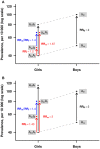Analysis of Parent-of-Origin Effects on the X Chromosome in Asian and European Orofacial Cleft Triads Identifies Associations with DMD, FGF13, EGFL6, and Additional Loci at Xp22.2
- PMID: 29520293
- PMCID: PMC5827165
- DOI: 10.3389/fgene.2018.00025
Analysis of Parent-of-Origin Effects on the X Chromosome in Asian and European Orofacial Cleft Triads Identifies Associations with DMD, FGF13, EGFL6, and Additional Loci at Xp22.2
Abstract
Background: Although both the mother's and father's alleles are present in the offspring, they may not operate at the same level. These parent-of-origin (PoO) effects have not yet been explored on the X chromosome, which motivated us to develop new methods for detecting such effects. Orofacial clefts (OFCs) exhibit sex-specific differences in prevalence and are examples of traits where a search for various types of effects on the X chromosome might be relevant. Materials and Methods: We upgraded our R-package Haplin to enable genome-wide analyses of PoO effects, as well as power simulations for different statistical models. 14,486 X-chromosome SNPs in 1,291 Asian and 1,118 European case-parent triads of isolated OFCs were available from a previous GWAS. For each ethnicity, cleft lip with or without cleft palate (CL/P) and cleft palate only (CPO) were analyzed separately using two X-inactivation models and a sliding-window approach to haplotype analysis. In addition, we performed analyses restricted to female offspring. Results: Associations were identified in "Dystrophin" (DMD, Xp21.2-p21.1), "Fibroblast growth factor 13" (FGF13, Xq26.3-q27.1) and "EGF-like domain multiple 6" (EGFL6, Xp22.2), with biologically plausible links to OFCs. Unlike EGFL6, the other associations on chromosomal region Xp22.2 had no apparent connections to OFCs. However, the Xp22.2 region itself is of potential interest because it contains genes for clefting syndromes [for example, "Oral-facial-digital syndrome 1" (OFD1) and "Midline 1" (MID1)]. Overall, the identified associations were highly specific for ethnicity, cleft subtype and X-inactivation model, except for DMD in which associations were identified in both CPO and CL/P, in the model with X-inactivation and in Europeans only. Discussion/Conclusion: The specificity of the associations for ethnicity, cleft subtype and X-inactivation model underscores the utility of conducting subanalyses, despite the ensuing need to adjust for additional multiple testing. Further investigations are needed to confirm the associations with DMD, EGF16, and FGF13. Furthermore, chromosomal region Xp22.2 appears to be a hotspot for genes implicated in clefting syndromes and thus constitutes an exciting direction to pursue in future OFCs research. More generally, the new methods presented here are readily adaptable to the study of X-linked PoO effects in other outcomes that use a family-based design.
Keywords: GWAS; Haplin; X chromosome; birth defects; case-parent triads; genetic epidemiology; orofacial clefts; parent-of-origin.
Figures





Similar articles
-
A new approach to chromosome-wide analysis of X-linked markers identifies new associations in Asian and European case-parent triads of orofacial clefts.PLoS One. 2017 Sep 6;12(9):e0183772. doi: 10.1371/journal.pone.0183772. eCollection 2017. PLoS One. 2017. PMID: 28877219 Free PMC article.
-
X-linked genes and risk of orofacial clefts: evidence from two population-based studies in Scandinavia.PLoS One. 2012;7(6):e39240. doi: 10.1371/journal.pone.0039240. Epub 2012 Jun 19. PLoS One. 2012. PMID: 22723972 Free PMC article.
-
A Genome-Wide Search for Gene-Environment Effects in Isolated Cleft Lip with or without Cleft Palate Triads Points to an Interaction between Maternal Periconceptional Vitamin Use and Variants in ESRRG.Front Genet. 2018 Feb 26;9:60. doi: 10.3389/fgene.2018.00060. eCollection 2018. Front Genet. 2018. PMID: 29535761 Free PMC article.
-
[Environment and genetics in the etiology of cleft lip and cleft palate with reference to the role of folic acid].Epidemiol Prev. 2000 Jan-Feb;24(1):21-7. Epidemiol Prev. 2000. PMID: 10748547 Review. Italian.
-
Breakthroughs in the genetics of orofacial clefting.Trends Mol Med. 2011 Dec;17(12):725-33. doi: 10.1016/j.molmed.2011.07.007. Epub 2011 Aug 30. Trends Mol Med. 2011. PMID: 21885341 Review.
Cited by
-
Genome-Wide Scan for Parent-of-Origin Effects in a sub-Saharan African Cohort With Nonsyndromic Cleft Lip and/or Cleft Palate (CL/P).Cleft Palate Craniofac J. 2022 Jul;59(7):841-851. doi: 10.1177/10556656211036316. Epub 2021 Aug 12. Cleft Palate Craniofac J. 2022. PMID: 34382870 Free PMC article.
-
The X-factor in ART: does the use of assisted reproductive technologies influence DNA methylation on the X chromosome?Hum Genomics. 2023 Apr 21;17(1):35. doi: 10.1186/s40246-023-00484-6. Hum Genomics. 2023. PMID: 37085889 Free PMC article.
-
FGF13 Is Required for Histamine-Induced Itch Sensation by Interaction with NaV1.7.J Neurosci. 2020 Dec 9;40(50):9589-9601. doi: 10.1523/JNEUROSCI.0599-20.2020. Epub 2020 Nov 10. J Neurosci. 2020. PMID: 33172979 Free PMC article.
-
Haplin power analysis: a software module for power and sample size calculations in genetic association analyses of family triads and unrelated controls.BMC Bioinformatics. 2019 Apr 2;20(1):165. doi: 10.1186/s12859-019-2727-3. BMC Bioinformatics. 2019. PMID: 30940094 Free PMC article.
-
Sex-specific genetic architecture of late-life memory performance.Alzheimers Dement. 2024 Feb;20(2):1250-1267. doi: 10.1002/alz.13507. Epub 2023 Nov 20. Alzheimers Dement. 2024. PMID: 37984853 Free PMC article.
References
LinkOut - more resources
Full Text Sources
Other Literature Sources
Miscellaneous

